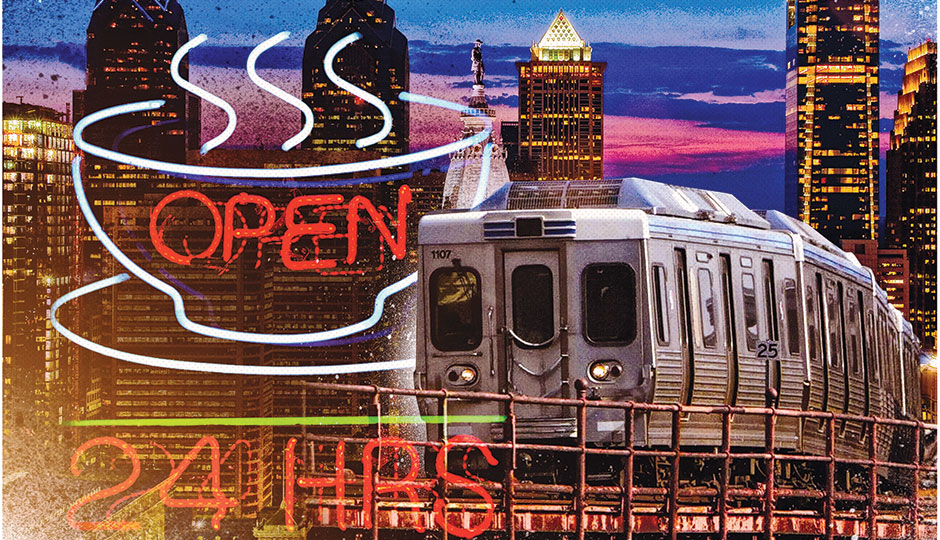Why Philly Refuses to Become a 24-Hour City

Illustration by Gluekit
Every so often, an out-of-towner crashes into Philly with a bold new idea. Almost inevitably, said out-of-towner runs into a brick wall. One recent example: An August story in the Inquirer detailed an audacious plan to transform a block in Callowhill into a world-class destination for late-night clubbing. The project — a luxury 16-story residential tower and 1,000-person dance club, complete with a Finnish sound system and bottle service — is the brainchild of a 24-year-old impresario from Connecticut who looks like a postpubescent Rick Moranis. Predictably, Philadelphians ripped the entire concept apart on social media, like pigeons attacking a day-old Amoroso roll.
Some of the mocking homed in on the underlying assumption that Philly could ever become a late-night destination. As one Reddit commenter put it: “I have a feeling this is going to fail miserably because it will come off as incredibly inauthentic in a city that does not have the glitz and glam of Miami or Vegas.”
Fair enough. Philly isn’t teeming with vacationing celebrities or bon vivants. Our idea of a good time after 2 a.m. involves gluttony (cheesesteaks), more gluttony (Wawa), and maybe some Gayborhood dancing. Compared to round-the-clock New York, Philly does close down a bit early. But are we really more quick-to-bed than other U.S. cities?
In 1995, the Urban Land Institute coined the term “24-hour city” and described such metropolises as those with 1) residential neighborhoods near downtown; 2) shopping districts close to job centers; 3) safe streets; 4) great mass transit; and 5) plenty of recreational and entertainment amenities. Having a critical mass of diurnal human beings was an implied characteristic, not a measuring stick in itself.
At the time, five U.S. cities — New York, Boston, D.C., San Francisco and Chicago — were considered the vanguard, while Philly was relegated to the frumpy nine-to-five pile. And our city remains there in the eyes of most people who care about this topic — despite the renaissance of Center City over the past 20 years.
However, consider this: Philly is one of just three American cities to offer 24-hour subway service. (We even beat London to that marker.) Research shows that Philadelphia has twice as many 24-hour drugstores as Boston or San Francisco. And Center City is a near-ideal mix of residential, retail and office buildings.
By the ULI’s working definition, Philly stacks up quite well. And yet anyone walking downtown in the wee hours of weekdays will confront mostly empty sidewalks and streets. There’s notably less car traffic between the hours of 1 a.m. and 5 a.m. here than in Chicago or Minneapolis or D.C. After an initial explosion of ridership for SEPTA’s all-night weekend subway service, usage eventually dipped and has since plateaued.
“Creating a 24-hour city is not just about assembling a list of ingredients: It is about having a good recipe and executing it well,” writes Hugh Kelly, a New York University professor and the author of 24-Hour Cities. In other words, Philadelphia has all the pieces for a pulsating all-night city, but there’s a cultural resistance to embracing it. Over the years, various attempts to extend last call beyond 2 a.m. have been beaten back by City Hall, neighborhood groups and state lawmakers. When certain venues were allowed to serve until 4 a.m. during the DNC, for the most part, only lame hotel bars stepped up. And earlier this year, SugarHouse Casino yawned when offered the chance to buy a 24-hour liquor license from Harrisburg. In Philly, the psyche is more happy-hour-or-bust than night owl.
Not even the millennials can change that. Studies have shown that young Americans are steering clear of the club scene, drinking less than their elders, and consuming 50 percent more television than Gen Xers. (Netflix-and-chill is real.)
So maybe Philly’s early-bird ways aren’t quite as unfashionable as they may seem.
Follow @MalcolmBurnley on Twitter.
Published as “Why Philly Refuses to Become a 24-Hour City” in the October 2016 issue of Philadelphia magazine.


